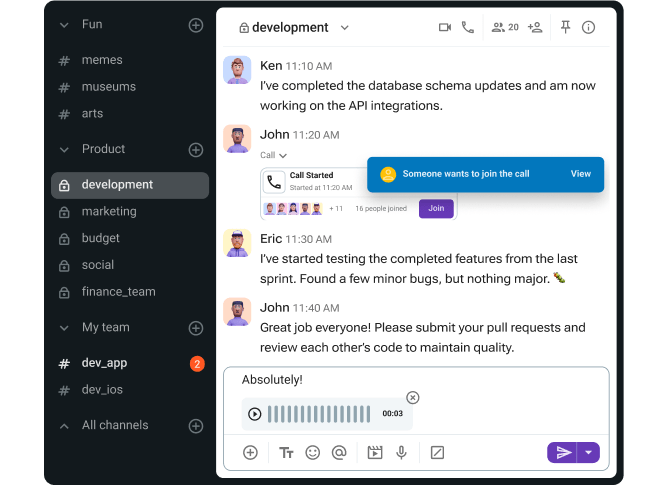La colaboración depende de un gran número de variables que determinan el rumbo y el éxito de la relación laboral. Si bien un gran porcentaje de esas variables reside en el ámbito impredecible del "factor humano", muchos factores impactantes son de naturaleza estructural, procesal y organizacional.
Nunca hay garantías de que una relación de colaboración resulte en un éxito grande, pero hay pasos que las organizaciones pueden tomar para establecer la colaboración sobre fundamentos saludables y permitir que los miembros del equipo colaboren exitosamente. Estos pasos están ahí para garantizar que la colaboración esté configurada para eliminar los obstáculos institucionales y preparar al equipo para el éxito.
A continuación examinaremos algunos de los requisitos previos más importantes para la colaboración que configuran y determinan en gran medida el curso y el resultado del trabajo conjunto.
Personal
El primer factor, y posiblemente el más importante, puede parecer un poco obvio y redundante porque todos queremos contratar y designar al mejor personal disponible para cualquier proyecto determinado. Sin embargo, no se trata de elecciones individuales específicas de personal, sino de la estructura del equipo. Al configurar un equipo colaborativo, es importante comprender lo que deseamos lograr y cómo lograrlo mejor - la estructura del equipo debe reflejar esa comprensión como una realización práctica del mejor camino definido hacia adelante.
¿Cuántas personas necesitamos en un equipo para lograr los objetivos definidos? ¿Qué conjuntos de habilidades debería incorporar el equipo? ¿Cómo interactuarán estos conjuntos de habilidades para obtener el mejor resultado posible? Las personas responsables de crear y organizar equipos colaborativos necesitan tener respuestas a estas preguntas de antemano para establecer equipos de manera lógica y funcional.
Además, la estructura del equipo debe ir acompañada de un sistema de apoyo a la colaboración en toda la organización. Este sistema de apoyo debe incluir una cultura organizacional inclusiva y basada en la confianza, la disponibilidad de todas las herramientas y recursos necesarios para una colaboración de calidad, prácticas formales e informales de coaching y tutoría para la mejora de las habilidades individuales (tanto profesionales como interpersonales), así como un mecanismo de reconocimiento y recompensa de prácticas colaborativas positivas.
Realiza la incorporación de tus nuevos empleados utilizando Pumble
División de roles
Se pueden establecer equipos colaborativos con diversos grados de estructura con respecto a los roles y responsabilidades individuales de los miembros del equipo. No hay dos equipos iguales y, si bien un equipo puede sobresalir en un marco estrictamente definido y estructurado, otro puede beneficiarse de un entorno más flexible e improvisado. Diferentes estilos se adaptan a diferentes grupos y diferentes tipos de trabajo, y si crees que un entorno más informal e improvisado sería adecuado para tu equipo, no hay razón para no intentarlo.
Sin embargo, la evidencia empírica sugiere que una división de roles clara y estructurada generalmente produce mejores resultados. Basándose en una extensa investigación, la reconocida autora Tamara J. Erickson afirma que "la colaboración mejora cuando los roles de los miembros individuales del equipo están claramente definidos y bien comprendidos". Erickson propone que una definición clara de roles y responsabilidades permite a los miembros del equipo realizar partes importantes de su trabajo de forma independiente. Por otro lado, la falta de esa claridad puede dar lugar a escenarios negativos, como la negociación de roles o la protección de las posiciones percibidas, lo que no sólo lleva mucho tiempo sino que también puede deteriorar gravemente las relaciones laborales.
Una división de roles clara y entendida no es lo mismo que rigidez de roles. Tener roles y responsabilidades claramente definidos no impide que los equipos se adapten a nuevas circunstancias y evolucionen los roles individuales de los miembros del equipo. Sin embargo, incluso a través de tales cambios, es importante comunicar plenamente los nuevos roles y responsabilidades de los miembros del equipo para garantizar que todos estén en sintonía y todos sean conscientes de lo que se espera de ellos.
Define roles y expectativas utilizando Pumble
Tecnología
Antes de que pueda comenzar el proceso de colaboración, las organizaciones deben proporcionar al equipo colaborativo todas las herramientas tecnológicas necesarias. Aparte de cualquier herramienta específica de la industria relevante para el funcionamiento del equipo, la principal preocupación de las organizaciones debe ser la tecnología de comunicación y colaboración.
La comunicación activa y saludable entre los miembros del equipo es la base de una colaboración de calidad. Todos los procesos relevantes para la colaboración (coordinación del trabajo, toma de decisiones, lluvia de ideas, resolución de problemas, etc.) se realizan mediante la comunicación.
Para colaborar adecuadamente, los miembros del equipo deben comunicarse de diversas maneras, tanto directa como indirectamente, a través de correo electrónico, chat, videollamadas, comentarios en documentos, etc. Además, los equipos probablemente necesitarán plataformas tecnológicas que les permitan intercambiar archivos y trabajar con ellos, de forma independiente y simultánea. La comunicación a nivel de equipo debe ser eficiente y urgente, pero también lo suficientemente flexible como para acomodar a los miembros del equipo en diferentes ubicaciones geográficas y zonas horarias. Depende de las organizaciones proporcionar un paquete tecnológico integral que permita a los equipos comunicarse y colaborar de diversas maneras, según sus necesidades y circunstancias específicas.
Coordinación del flujo de trabajo
La colaboración progresa de la espontaneidad y la improvisación, pero no debe estar enteramente guiada y ordenada únicamente por estas virtudes. La colaboración de calidad requiere un cierto grado de moderación y facilitación para garantizar que todos estén en sintonía y que el proceso se desarrolle de manera productiva.
Según una definición, la coordinación de equipos es “un proceso que implica el uso de estrategias y patrones de comportamiento destinados a integrar acciones, conocimientos y objetivos de miembros interdependientes, con el fin de lograr objetivos comunes”. En los equipos colaborativos, los miembros individuales del equipo trabajan de forma independiente e interdependiente, y todas estas actividades deben organizarse de manera que los una para lograr el mejor efecto.
La importancia de la coordinación crece aún más en equipos grandes, en proyectos complejos y en situaciones de cambios rápidos. En tales situaciones, la falta de coordinación conduciría inevitablemente al caos y el desorden.
La responsabilidad de coordinar el esfuerzo de un equipo suele confiarse a un líder de equipo, pero en equipos con una estructura menos jerárquica, también puede ser realizada por un coordinador de equipo o por consenso. Independientemente de la persona o entidad encargada de ello, la coordinación del equipo debe implicar las siguientes actividades:
- Hacer un uso eficiente de los recursos del personal y del equipo
- Programar actividades de manera que se eviten retrasos y pérdidas de tiempo
- Crear planes de contingencia para obstáculos imprevistos y situaciones emergentes
- Involucrar a miembros del equipo que posean experiencia relevante en la planificación de actividades del equipo
- Organizar reuniones de equipo para la planificación colectiva y la resolución de problemas
- Seguir y dirigir el trabajo del equipo y de sus miembros individuales
Coordina a tu equipo en Pumble
Objetivos compartidos
No hay colaboración sin una visión común compartida por todos los participantes. En el centro de la colaboración se encuentra la intención de unirse y aunar recursos para lograr un objetivo compartido. Es el hilo conductor entre los miembros del equipo que dirige sus esfuerzos individuales hacia un logro colectivo. Los autores Widmeyer y Ducharme definen las metas como “guías para la acción”, principios que informan todas las actividades del equipo.
Antes de que pueda comenzar la colaboración, es necesario que detrás de ella haya un propósito claro y aceptado colectivamente. Este propósito (o visión, como se llama más comúnmente) sirve no sólo para alinear al equipo en torno a un objetivo compartido, sino también para inspirar y motivar a los miembros del equipo hacia la realización de dicho objetivo. Como dijo Antoine de Saint-Exupéry: “Si quieres construir un barco, no obligues a la gente a recolectar madera y no les asignes tareas y trabajo, sino enséñales a anhelar la inmensidad infinita del mar."
Es importante distinguir la visión del equipo y las metas generales compartidas de las metas periódicas específicas que los miembros del equipo establecen a lo largo de su trabajo. Si bien estos últimos también son importantes para el éxito de la colaboración, representan la dimensión práctica de la visión global y su segmentación en tareas y responsabilidades individuales y colectivas, a través de diferentes técnicas como los objetivos SMART, por ejemplo. Es decir, se definen durante todo el proceso de colaboración, y no antes.
Los objetivos compartidos, como requisito previo para la colaboración, deben comunicarse claramente (qué son y por qué son importantes), y deben entenderse y adoptarse colectivamente como una brújula para todas las actividades futuras.
Pumble: El ingrediente final para la colaboración en equipo
A medida que las organizaciones se esfuerzan por mejorar la colaboración en equipo, la integración de Pumble en su flujo de trabajo puede mejorar significativamente sus esfuerzos.
Pumble es un software de colaboración en equipo que ofrece una gran cantidad de funciones diseñadas específicamente para abordar los requisitos previos clave descritos en este artículo, fomentando un entorno colaborativo más productivo.
Pumble tiene permisos y roles de usuario personalizables que permiten a los equipos asignar responsabilidades de manera eficiente y garantizar la claridad dentro de sus proyectos. Además, es el canal de comunicación todo en uno ideal para una coordinación perfecta. Su conjunto de funciones de comunicación, que incluyen mensajes directos, intercambio de archivos, y videoconferencias, elimina la necesidad de comunicación a través de múltiples plataformas.
Con Pumble como centro de colaboración, los equipos pueden:
- Trabajar juntos de manera más efectiva,
- Alcanzar sus objetivos de manera eficiente y, en definitiva,
- Impulsar un mayor éxito organizacional.



